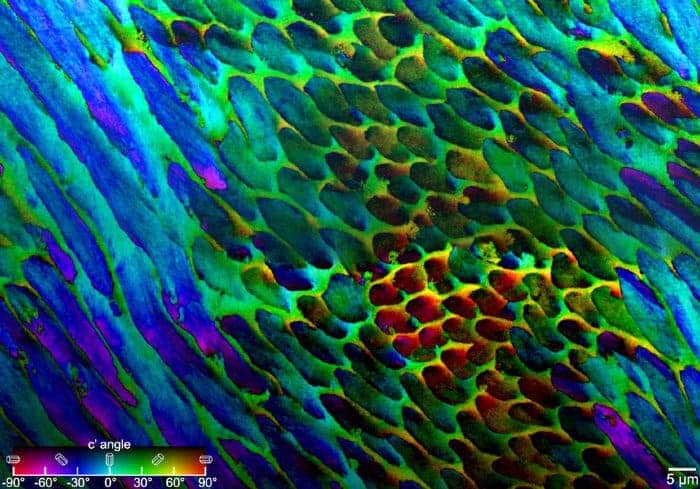A first-of-its-kind look at the nanostructure of tooth enamel helps uncover the secret of the hardest substance in the human body.

Image credits Pupa Gilbert.
While the enamel on our teeth looks pretty much like bone, it’s not actually living tissue (while bones are). Enamel grows while teeth are developing to encase all the other material in our teeth and provides protection. Once the teeth are fully developed, they lose the ability to repair or grow new enamel. It’s not so bad, though: enamel is incredibly tough and harder, pound for zpound, than steel.
The skin of our teeth
“We apply huge pressure on tooth enamel every time we chew, hundreds of times a day,” says biophysicist Pupa Gilbert from the University of Wisconsin-Madison. “Tooth enamel is unique in that it has to last our entire lifetime. How does it prevent catastrophic failure?”
The new study reports it all comes down to enamel’s “hidden structure”. The outer layer of our teeth, they explain, is constructed out of a complex weave of hydroxyapatite nanocrystals. Hydroxyapatite is a phosphate mineral from the apatite family that contains calcium and makes up to 70% of our bones by weight.
In tooth enamel, hydroxyapatite takes the shape of crystals one-thousandth the thickness of human hair. They’re so small, the team explains, that nobody has been able to get a proper look at them until now.
“Prior to this study, we just didn’t have the methods to look at the structure of enamel,” Gilbert says. “But with a technique that I previously invented, called polarisation-dependent imaging contrast (PIC) mapping, you can measure and visualise in colour the orientation of individual nanocrystals and see many millions of them at once.”
Using the PIC technique on human tooth enamel, the team spotted that the hydroxyapatite nanocrystals were not oriented in as we had previously assumed. Instead, they’re bundled up into ‘rods’ and ‘interrods’. The team further describes a gradual change in the orientation between adjacent nanocrystals that was similarly unexpected. Differences in orientation between adjacent crystals ranged between 1 and 30 degrees, they report.
“We propose that mis-orientation of adjacent enamel nanocrystals provides a toughening mechanism,” the study reads. “If all crystals are co-oriented, a transverse crack can propagate across crystal interfaces, whereas if the crystals are mis-oriented a crack primarily propagates along the crystal interfaces.”
While testing their hypothesis in real life would be very difficult, computer modeling of the enamel’s structure and its behavior supports the team’s view. These models showed that cracks could spread through enamel’s crystal structure through pressure and how, also revealing that cracks propagated more quickly through perfectly-aligned crystal networks. The researchers therefore believe that the angles of mis-orientation they found in enamel is the best at deflecting cracks, selected for over the course of millions of years of natural evolution.
“Crack deflection is a well-established toughening [mechanism], we therefore conclude that in enamel the observed mis-orientations play a key mechanical role: they increase the toughness of enamel at the nanoscale, which is fundamentally important to withstand the powerful masticatory forces, approaching 1,000 newtons, repeated thousands of times per day.”
The paper “The hidden structure of human enamel” has been published in the journal Nature Communications.






